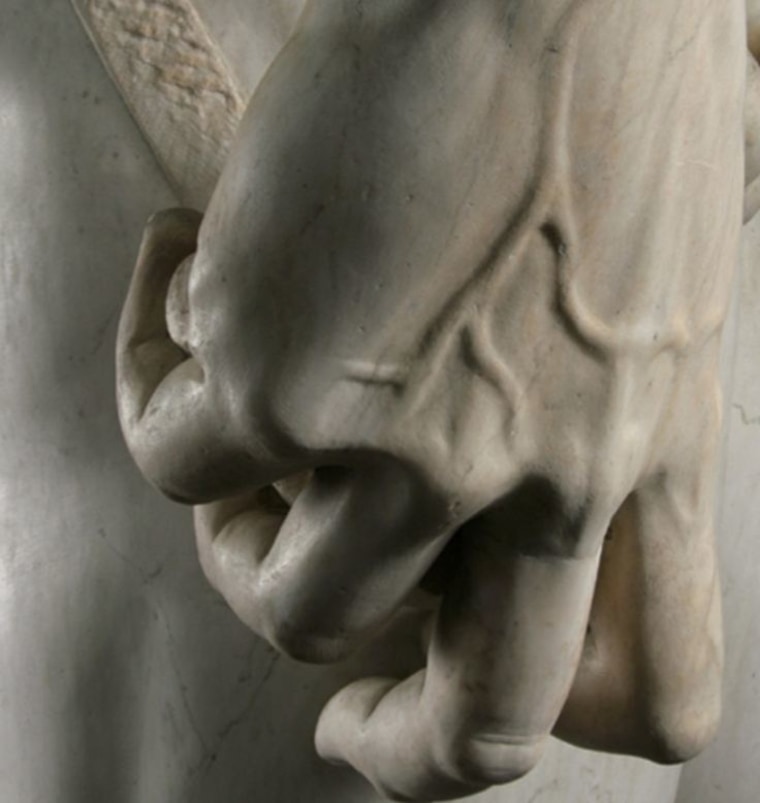Michelangelo's David might have held a secret weapon in his overly large right hand, according to new controversial research into the towering depiction of the biblical hero who killed Goliath.
Presented at "Florens 2010: The International Week of Cultural and Environmental Heritage," during a three-day tribute to Michelangelo’s masterpiece, the study concludes that David’s right hand is gripping the cylindrical fragment of a weapon.
“Bulging with veins, the right hand is holding what remains of a terrible weapon used in antiquity until the 17th century,” art historians Sergio Risaliti and Francesco Vossilla wrote in the book “L’Altro David” (“The Other David).
Called a fustibal, or staff-sling, the weapon was used to throw stones.
“With a leather sling attached to the end, the staff acted like a portable trebuchet (a large catapult-like device)," classical folklorist Adrienne Mayor, who was not involved in the study, told Discovery News.
The Bible says that when David went to fight Goliath, he took up his shepherd's staff, five smooth stones and his sling.
Of these, only the latter is represented in Michelangelo’s sculpture, as David holds the pouch of the sling in his left hand, above his shoulder.
Crossing his back down to the right hand, the straps of the rather long sling appear to be attached to a mysterious object.
“We believe the object is actually the handle to which a staff had to be mounted, much alike a golf pole,” Risaliti told Discovery News.
Combining the right hand and the left hand, the staff and the sling, Michelangelo would have actually fitted David with a fustibal, according to the researchers.
Standing high atop the Cathedral — this was the destination first envisioned for the sculpture — the weapon would have remained secret, as people would have only seen David holding a staff in his right hand and the sling’s pouch in his left.
“The staff was perfectly fitting a statue originally commissioned for Florence Cathedral. It would have rendered the biblical depiction of the shepherd boy,” Risaliti said.
Boasting a range of up to 600 feet, the fustibal was known since Roman times, and was first mentioned by the 4th century A.D. military writer Vegetius.
According to the researchers, it was also well known when Michelangelo (1475 –1564) begun sculpting his David in 1501.
Represented in several drawings by Leonardo Da Vinci (1452 –1519), the fustibal also appears in the artist's Lorenzo Ghiberti’s "Gates of Paradise" on the east portal of the Baptistery — in the panel in which Ghiberti (1378 –1455) depicts David’s victory over Goliath.
The researchers speculate that the fustibal in the panel might have influenced Michelangelo, who greatly admired Ghiberti’s work.
The staff, however, was never mounted on the handle, likely because of the decision to display the 17-foot naked marble man beside the main doorway of the Piazza della Signoria.
“A shepherd staff wasn’t fitting with the political meaning of the statue, which became the first public Italian monument,” Risaliti said.
Transformed into a symbol of the republican freedom, David was first shown in Piazza Signoria on Sept. 8, 1504, and there it remained, at the mercy of the elements, until 1873 when it was moved to its present location in the Galleria dell'Accademia.
Other scholars are skeptical about the staff sling theory. According to American art historian Lynn Catterson, David is simply holding the handle portion of the sling.
“It acts as a brace or buttress, to protect the fingers which are a very fragile portion of the sculpture,” Catterson told Discovery News.
Cristina Acidini, superintendent of Florence museums, agrees with Catterson that David is holding the handle of the sling, which according to her is made from a horn.
“Many conjectures have been made about this object [some also speculate it is the stone David will hurl at Goliath’s head]. After 500 years, Michelangelo’s David continues to raise questions and interpretations,” Acidini told Discovery News.
